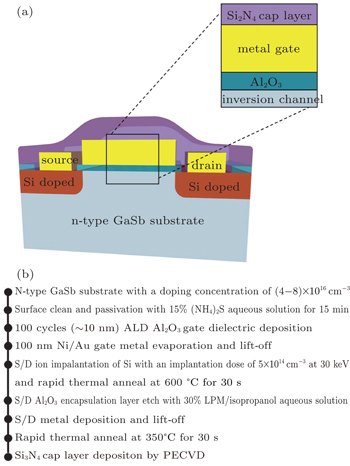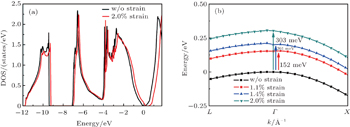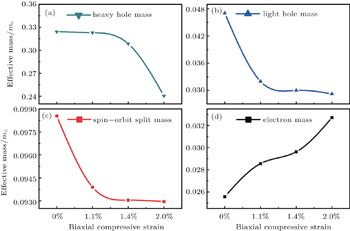† Yan-Wen Chen and Zhen Tan contributed equally to this work.
‡ Corresponding author. E-mail:
Project supported by the National Basic Research Program of China (Grant No. 2011CBA00602) and the National Science and Technology Major Project of the Ministry of Science and Technology of China (Grant No. 2011ZX02708-002).
Various biaxial compressive strained GaSb p-channel metal–oxide–semiconductor field-effect transistors (MOSFETs) are experimentally and theoretically investigated. The biaxial compressive strained GaSb MOSFETs show a high peak mobility of 638 cm2/V·s, which is 3.86 times of the extracted mobility of the fabricated GaSb MOSFETs without strain. Meanwhile, first principles calculations show that the hole effective mass of GaSb depends on the biaxial compressive strain. The biaxial compressive strain brings a remarkable enhancement of the hole mobility caused by a significant reduction in the hole effective mass due to the modulation of the valence bands.
High mobility III–V semiconductors have attracted a great deal of attention, they are considered as candidates to replace strained-Si in future high-performance metal–oxide–semiconductor field-effect transistors (MOSFETs).[1–3] Recent studies on III–V MOSFETs focus on gate-stack and interface engineering.[4,5] Many high performance III–V channel MOSFETs have been reported.[6–9] However, research on p-channel III–V MOSFETs has traditionally lagged in comparison to n-channel III–V MOSFETs.[10] GaSb has very high hole mobility (∼1000 cm2/V·s), making it attractive as an alternative channel material to silicon, especially for the p-channel MOSFET application.[10–12] The hole mobility of GaSb is twice as high as that of silicon and GaAs.[13] To date, many efforts have been made for the GaSb MOSFET application, such as the source/drain technology and the gate stacks technology.[14,15] Although GaSb MOSFETs have been demonstrated by some research groups, further improvements in the performance of GaSb p-channel MOSFETs are badly needed. If the hole mobility of GaSb can be further enhanced, GaSb p-channel MOSFETs will obtain a wide range of applications in the future.
Strain engineering is considered as one of the most promising technologies to improve the mobility of III–V MOSFETs.[16] Physical understanding of the strain effect in the MOSFETs is also of great importance. The carrier mobility enhancement of strained III–V semiconductors, such as GaAs and InGaAs, has been intensively studied.[16–18] By regrowing lattice-mismatched source and drain regions, the strain has been employed to obtain the electron mobility enhancement in InGaAs.[19] The uniaxial strain effects on the mobility have been studied by wafer bending experiments, from which promising results on hole mobility in uniaxial strained GaSb p-channel MOSFETs were presented.[20,21]
In this paper, GaSb p-channel MOSFETs with Al2O3 gate dielectric, source, and drain formed by ion implantation that are self-aligned with respect to the gate are experimentally demonstrated, and various biaxial compressive strains are introduced by depositing an Si3N4 cap layer. The mobility of the strained GaSb MOSFETs is 3.86 times as high as that of the control samples without strain. Meanwhile, the employment of first principles calculations facilitates our understanding of the biaxial compressive strain acting on the carrier effective masses of GaSb. We find that the mechanism of mobility enhancement is the modulation of the valence band.
The MOSFETs, as shown in Fig.
The experimental Id–Vg characteristics of various biaxial compressive strained GaSb p-channel MOSFETs with Vd at −1 V and −0.05 V are shown in Figs.
 | Fig. 1. (a) Schematic diagram of biaxial compressive strained GaSb MOSFETs. (b) Process flow of self-aligned GaSb channel MOSFETs. |
The experimental Id–Vd characteristics of 2.0% biaxial compressive strained GaSb p-channel MOSFETs with gate voltages ranging from 1.5 V to −4 V are illustrated in Fig.
The hole mobility is extracted using a split-CV analysis based on the Id–Vg characteristics of the devices with various biaxial compressive strains, as shown in Fig.
It is widely known that the effective mass is a key factor that determines the carrier mobility. To understand the physical origin of the enhancement of mobility, we next turn to study the the effective mass of GaSb under different biaxial compressive strains using first principles calculations.
Our calculations are performed using density functional theory (DFT) as implemented in the Vienna ab initio simulation package (VASP).[26] We use the projector augmented wave (PAW) method, with the exchange–correlation potential described by local density approximation (LDA). The energy cut-off is set at 400 eV. We use Monkhorst–Pack k-point meshes of 9×9×9. All the structures are relaxed until the residual forces on each atom are no more than 0.01 eV/Å. The spin–orbital interactions are considered in the structural relaxation as well as in the electronic structure calculations.
Crystalline GaSb has a zinc-blende structure, belonging to the space group 


The calculated effective masses of holes and electrons are shown in Fig.
For semiconductors, the smaller the effective mass, the higher the carrier mobility.[28] Obviously, the dramatic decrease of the hole effective mass of GaSb under biaxial compressive strain will result in the significant enhancement of the hole mobility, which agrees well with the experimental finding. Although the interface roughness also plays a vital role in carrier scattering and thus mobility,[29–31] the surface roughness of our GaSb substrates is carefully controlled and all of the samples have similar surface roughness, so we believe that the mobility enhancement is mostly due to the decrease of the hole effective mass.
 | Fig. 4. (a) Density of states with and without 2% biaxial compressive strain. (b) Modulation of the valence band maximum. |
The reduction of the hole effective mass is attributed to the strain-induced modulation of the valence band, which is verified by the calculated electronic structure of GaSb. The calculated densities of states (DOS) before and after inducing 2.0% biaxial compressive strain are illustrated in Fig.
We have studied various biaxial compressive strained GaSb p-channel MOSFETs both experimentally and theoretically. The biaxial compressive strain results in the reduction of the hole effective mass by the modulation of the valence band, thus enhancing the hole mobility of GaSb. Our experimental and theoretical work makes it possible to fabricate high performance GaSb p-channel MOSFETs.
| 1 | |
| 2 | |
| 3 | |
| 4 | |
| 5 | |
| 6 | |
| 7 | |
| 8 | |
| 9 | |
| 10 | |
| 11 | |
| 12 | |
| 13 | |
| 14 | |
| 15 | |
| 16 | |
| 17 | |
| 18 | |
| 19 | |
| 20 | |
| 21 | |
| 22 | |
| 23 | |
| 24 | |
| 25 | |
| 26 | |
| 27 | |
| 28 | |
| 29 | |
| 30 | |
| 31 | |
| 32 |




